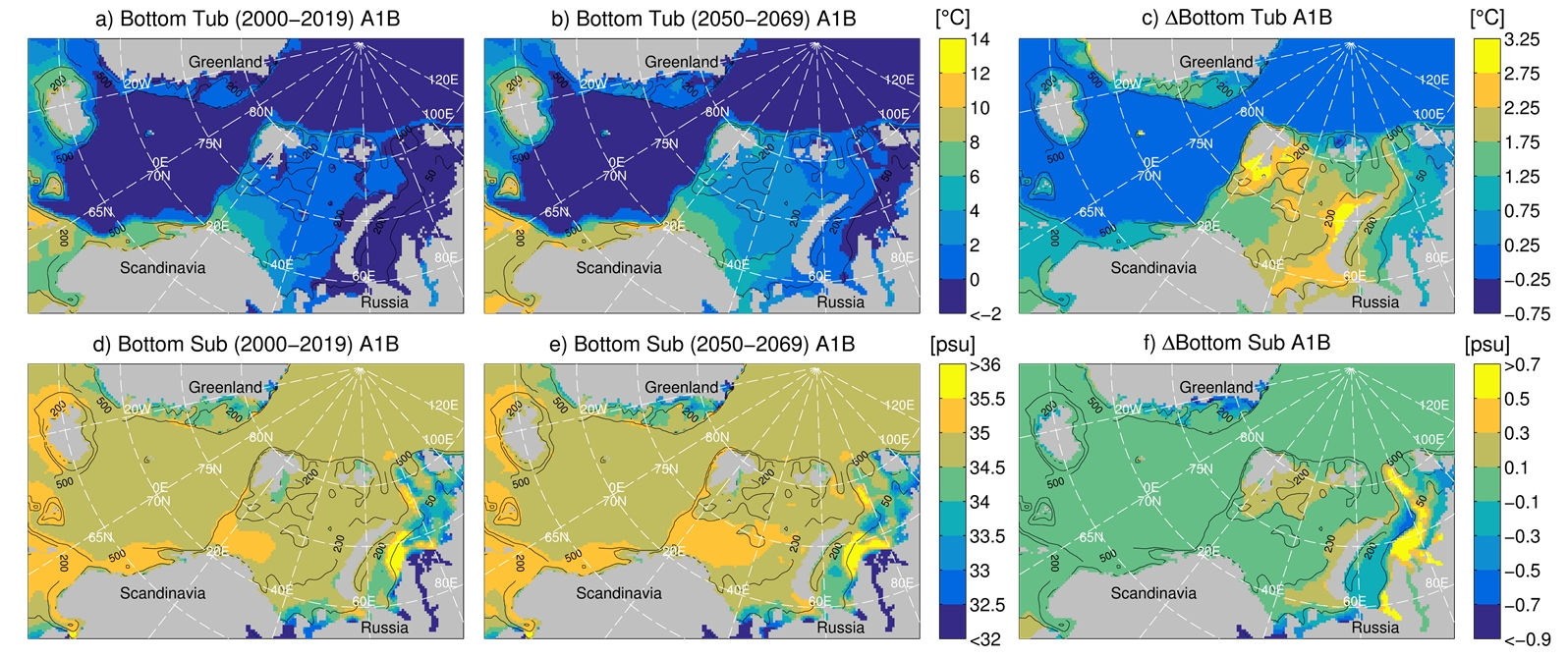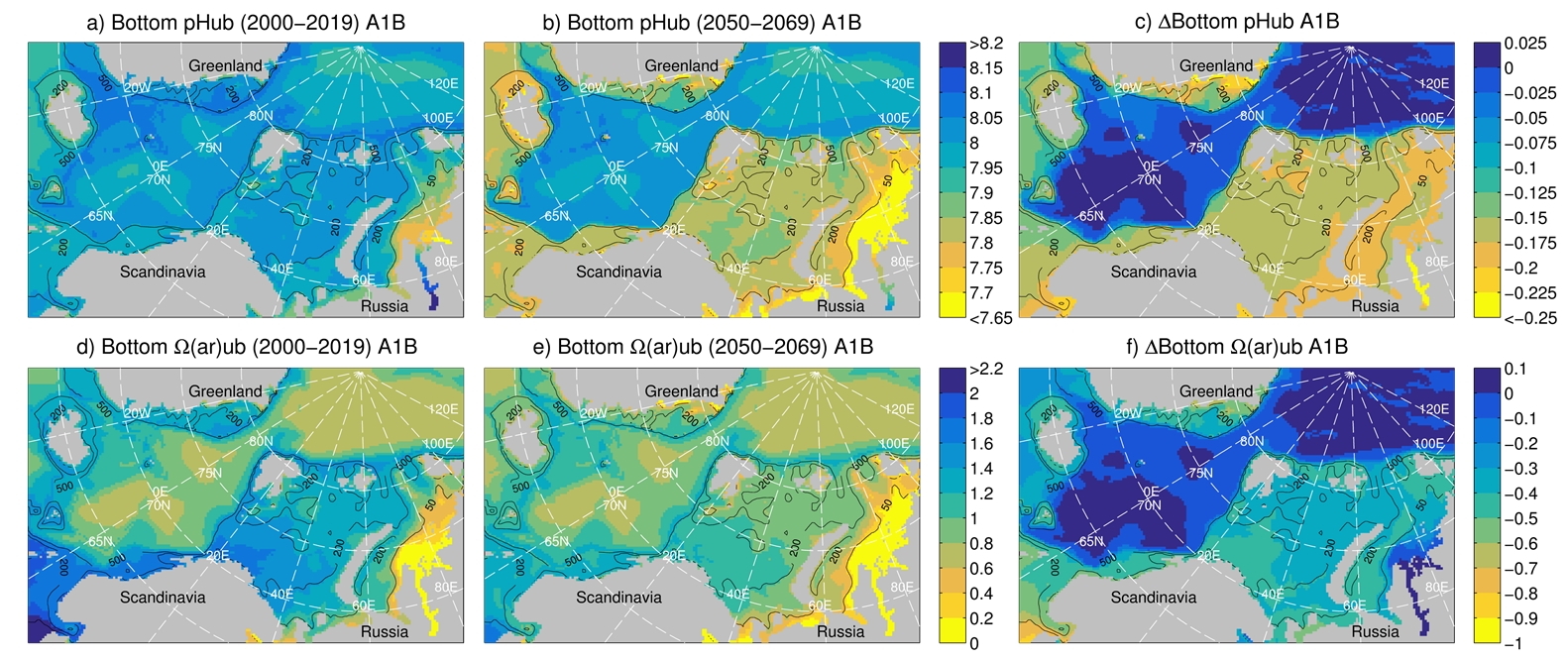|
|
R4 - Future Arctic Ocean Change and Society
In order to simulate future decadal and centennial changes of hydrography and biogeochemistry (T4.1), the SINMOD model was run for 2001-2099 under scenario SRES A1B using atmospheric forcing from the REMO regional climate model and boundary conditions from the Bergen Climate Model, applying the same boundary bias correction as in T1.5 (see Slagstad et al., 2015 and Bellerby et al., 2012 for details). The final SINMOD A1B output was bias-corrected using the bias estimates developed during T1.4. Focussing on 50-year climatic changes, we mainly compared output for 2000–2019 vs. 2050–2069, using bias-corrected output from the A1B scenario run to compute both bidecadal averages.
Within the POL-NOR focus region, SINMOD bottom water shows 50-year warming of 0.75–2.25 °C on most of the shelves, reaching 2.25–3.25 °C in the shallows of the northern and eastern Barents Sea (Figure 1a-c). The same areas also undergo salinization (Figure 1f), suggesting a north-/eastward intrusion of Atlantic water, pushing back the cooler and fresher Arctic water. Bottom pH shows rapid acidification on the shelves, with bidecadal averages at depths 50–500 m reaching 7.7–7.8 by 2060 (Figure 2a,b). The Norwegian Shelf, Barents Sea, Kara Sea, and East Greenland Shelf all experience roughly a 0.15–0.20 units decrease (Figure 2c). Both present and future values of bottom Ωar show undersaturation (Ωar < 1) in the deep basins and in the Kara Sea (Figure 2d,e), but the future period also shows undersaturation on the northern/eastern Barents and East Greenland shelves (Figure 2e). The decrease in Ωar is by 0.3–0.6 units over most of the Norwegian Shelf and Barents/Kara Seas, reaching 0.6–0.9 units in the northern North Sea and East Greenland Shelf (Figure 2f). Considering threshold years, already by 2010 there is seasonal undersaturation with respect to aragonite over most of the Kara Sea as well as in the deep basins (Figure 3a). By 2040 the undersaturation has spread to the deeper Kara Sea as well as the shallower parts (mostly < 200 m) of the northern/eastern Barents and East Greenland shelves. By 2070 most of the Barents and East Greenland shelf bottom water is undersaturated with respect to Ωar. The south-western Barents Sea and the Norwegian Shelf down to 500 m depth become seasonally undersaturated with respect to Ωar during 2070–2090, although some of the shallower parts escape perennial undersaturation during this century. Bottom water undersaturation with respect to calcite during the 21st century and within the study region is confined to the Kara Sea and East Greenland Shelf at depths < 200 m, plus the deep Eurasian Basin (Figure 3b).
The model output was analysed to assess bottom water seasonal and interannual variability. Seasonal variability was strongest in the shallow regions off the Svalbard and Russian coasts, while interannual variability was strongest in the northern Barents Sea off Svalbard, in the eastern Barents Sea off Novaya Zemlya, and in the eastern Kara Sea. Seasonal and interannual variations were much larger, relative to climatic changes, for temperature than forCO2chemistry variables. Although levels of seasonal/interannual variability have been used to predict the sensitivity of organisms to baseline changes in other studies, we concluded that this could not be reliably applied in the present instance, in part because of the generally low levels of variability in bottom water within the focus depth range of 50-500 m.
To identify regional hotspots of change and risk for key organisms/ecosystems (T4.2, T4.4) and project changes in benthic biodiversity (T4.3), the bias-corrected SINMOD projections for temperature and saturation state were combined to map niches for bottom water environment, using thresholds based on analyses from WP2 (Figure 4). In the present day, the influence of Atlantic Water extends a warm, oversaturated niche (T > 6°C, Ωar > 1.5) over the North Sea and Norwegian Shelf (Figure 4a, light blue), and a cooler, oversaturated niche (T < 6°C, Ωar > 1.5) in the south-west Barents Sea (Figure 4a, moderate/dark blue). The influence of Arctic and coastal water extends a cold, weakly-saturated niche (T < 4°C, 1.0 < Ωar < 1.5) over the norther/eastern Barents Sea and the East Greenland shelf (Figure 4a, dark green) and a cold, undersaturated niche (T > 4°C, Ωar < 1.0) over the Kara Shelf (Figure 4a, dark red). In the future period (2050-2069), the oversaturated niches are almost entirely excluded from the focus region, replaced by weakly-saturated niches (Figure 4b, light blue/green colors). The weakly-saturated niche is excluded from the northern Barents Sea and East Greenland Shelf, replaced by the cold, undersaturated niche (Figure 4b, dark green/red). Warming opens some new niches south of Iceland and in the south-eastern Barents Sea (Figure 4b, orange and red).

|
|
|
Figure 1. Bias-corrected SINMOD projections for bottom temperature (upper) and salinity (lower) under SRES A1B scenario. Left and middle plots show bidecadal averages over (2000─2019) and (2050─2069) respectively, and right plots show the differences. Black lines show 50, 200, and 500 m depth contours.
|

|
|
|
Figure 2. Bias-corrected SINMOD projections for bottom pH (upper) and aragonite saturation state (lower) under the SRES A1B scenario. Left and middle plots show bidecadal averages over (2000─2019) and (2050─2069) respectively, and right plots show the differences. Black lines show 50, 200, and 500 m depth contours.
|

|
|
|
Figure 3. Threshold years for the onset of seasonal bottom water undersaturation with respect to aragonite (a) and calcite (b). Colors show the last years for which the climatic (20-year moving average) seasonal minimum bottom saturation state is > 1. Black lines show 50, 200, and 500 m depth contours.
|

|
|
|
Figure 4. Geographical coverage of the nine different environmental niches defined by temperature and aragonite saturation state (see color matrix), for both the present-day period (a) and the future period (b). Black lines show 50, 200, and 500 m depth contours.
|
References:
-
Bellerby, R. G. J., A. Silyakova, G. Nondal, D. Slagstad, J. Czerny, T. de Lange, A. Ludwig, and B. Discussions (2012), Marine carbonate system evolution during the EPOCA Arctic pelagic ecosystem experiment in the context of simulated Arctic ocean acidification, Biogeosciences Discuss., 9(11), 15541–15565.
-
Slagstad, D., P. F. J. Wassmann, and I. Ellingsen (2015), Physical constrains and productivity in the future Arctic Ocean, Front. Mar. Sci., 2(October), 1–23.
|
|

